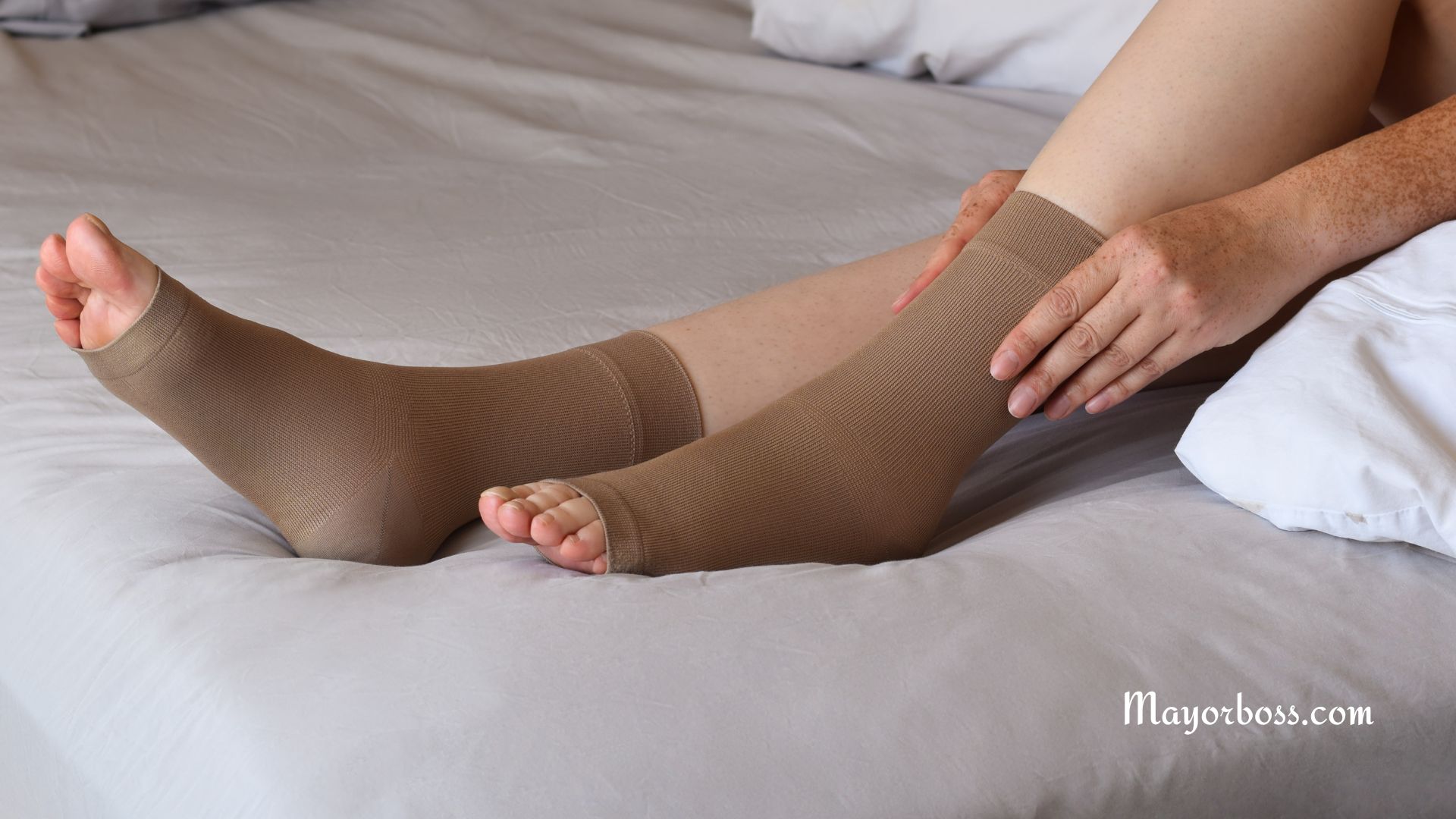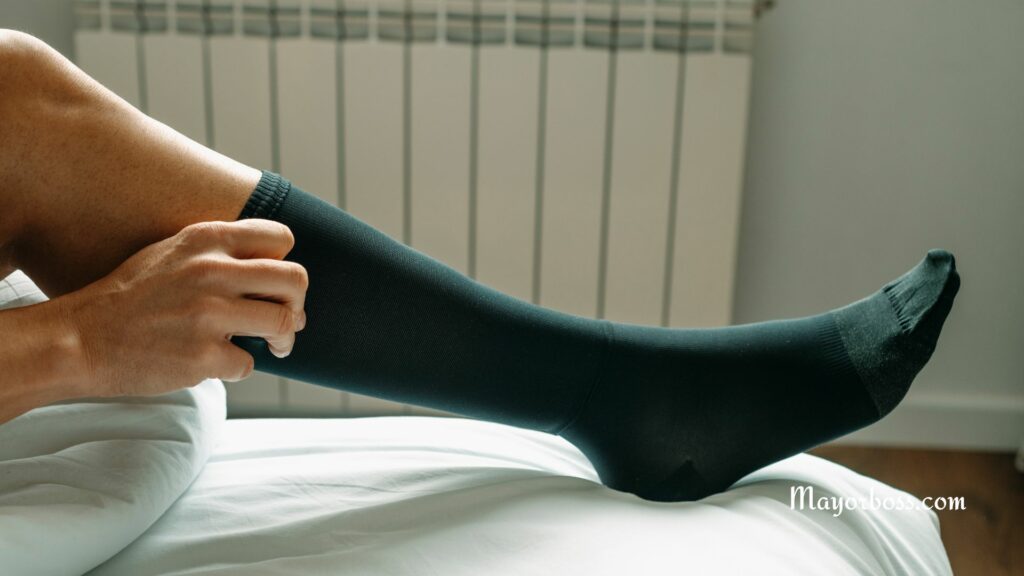What are Compression Socks Used For?
Compression socks are specialized hosiery designed to improve blood circulation, reduce swelling, and offer relief from discomfort. Typically worn on the legs, these socks are commonly used to manage conditions like varicose veins and edema and to prevent blood clots. They also find applications in sports and everyday life to alleviate fatigue.
So, what makes compression socks special? These aren’t your regular socks. They apply pressure to your lower legs, helping to maintain blood flow and minimize swelling. This magic is all thanks to the graduated compression they offer. In simpler terms, they are tighter at the ankle and less tight as they move up your leg. This design encourages blood to flow back towards your heart instead of pooling in your legs.
Medical Uses

Varicose Veins
If you’ve ever seen those enlarged, twisted veins, usually appearing blue or dark purple, you’ve encountered varicose veins. Compression socks are often recommended to alleviate symptoms like aching and swelling. Research suggests that these socks can improve the quality of life for people with this condition.
Edema and Swelling
Swelling in the legs or ankles can be annoying. Compression socks squeeze these areas to force the fluid back into the bloodstream. This is particularly useful for people who have to stand or sit for extended periods.
Preventing Blood Clots
Sitting for a long time, like during a long-haul flight, puts you at risk of developing blood clots. Wearing compression socks can help prevent conditions like deep vein thrombosis (DVT). According to medical guidelines, these socks are a non-invasive way to reduce this risk.
Post-Surgical Recovery
After surgery, especially on the lower extremities, doctors often recommend wearing compression socks. They aid in faster healing by reducing swelling and enhancing circulation.
Athletic Applications
You don’t have to be dealing with a medical issue to benefit from compression socks. Many athletes wear them to improve performance and reduce muscle fatigue. Research has linked the use of these socks to quicker recovery times post-exercise.
Running and Endurance Sports
In running and other endurance sports, wearing compression socks can help improve oxygen delivery to muscles, which in turn may enhance performance and lessen muscle strain.
Team Sports
In sports that require quick movements and changes in direction, like basketball or soccer, compression socks can provide extra ankle support and reduce the risk of injuries.
Everyday Benefits

Not an athlete or dealing with a medical condition? No worries, you can still benefit from these magical socks.
Improved Circulation
If you’re stuck at a desk all day, compression socks can help prevent the sluggish feeling you get in your legs. Improved blood flow can make a world of difference.
Less Fatigue
Do you feel like your legs are dragging after a long day? Wearing compression socks can relieve that feeling of fatigue and heaviness. Research suggests that they are effective in this regard.
Pregnancy
For expectant moms dealing with swollen feet and legs, compression socks can offer relief. They are often recommended for reducing swelling and discomfort during pregnancy.
In essence, from medical applications to athletic performance and everyday use, compression socks are versatile tools that offer various benefits. So, whether you’re recovering from surgery, running a marathon, or just enduring a long day at the office, these socks might just be what you need.
Frequently Asked Questions
What’s the Best Way to Wear Compression Socks?
Putting on compression socks isn’t the same as slipping on your everyday socks. You should start by bunching up the sock and then pulling it over your foot. Smooth it out from your ankle upwards, making sure there are no wrinkles or folds. Also, it’s generally recommended to put them on first thing in the morning when swelling is minimal.
How Long Should You Wear Compression Socks Each Day?
Compression socks are safe to wear all day, daily. However, the duration for which you should wear compression socks varies depending on the reason you’re wearing them. For medical conditions, it’s crucial to follow your healthcare provider’s advice. However, for general use or athletic activities, wearing them during the activity and a few hours after should suffice. Regardless, you should take them off before going to bed.
Can You Wear Compression Socks While Sleeping?
Unless specifically advised by a healthcare professional, it’s not recommended to wear compression socks while sleeping. The reason is that your blood circulation changes when you’re lying down. Wearing these socks while sleeping could put too much pressure on your legs, potentially causing more harm than good.
Are There Any Side Effects to Wearing Compression Socks?
While compression socks are generally safe, they can cause some issues if not used correctly. These may include skin irritation, discomfort, or even worsening of symptoms if the compression level is not appropriate. Therefore, consult a healthcare provider for proper guidance, especially if you’re using them for medical reasons.
How Do I Choose the Right Compression Socks for Me?
Selecting the right compression socks involves several factors. One is the level of compression, usually measured in millimeters of mercury (mmHg). Light compression is around 15-20 mmHg, while stronger compression can go up to 30-40 mmHg or more. Another factor is the material; they come in various fabrics like nylon, cotton, or spandex. Lastly, consider the length; they range from knee-high to thigh-high options. Your choice should be based on your specific needs and, if applicable, your healthcare provider’s recommendations.






